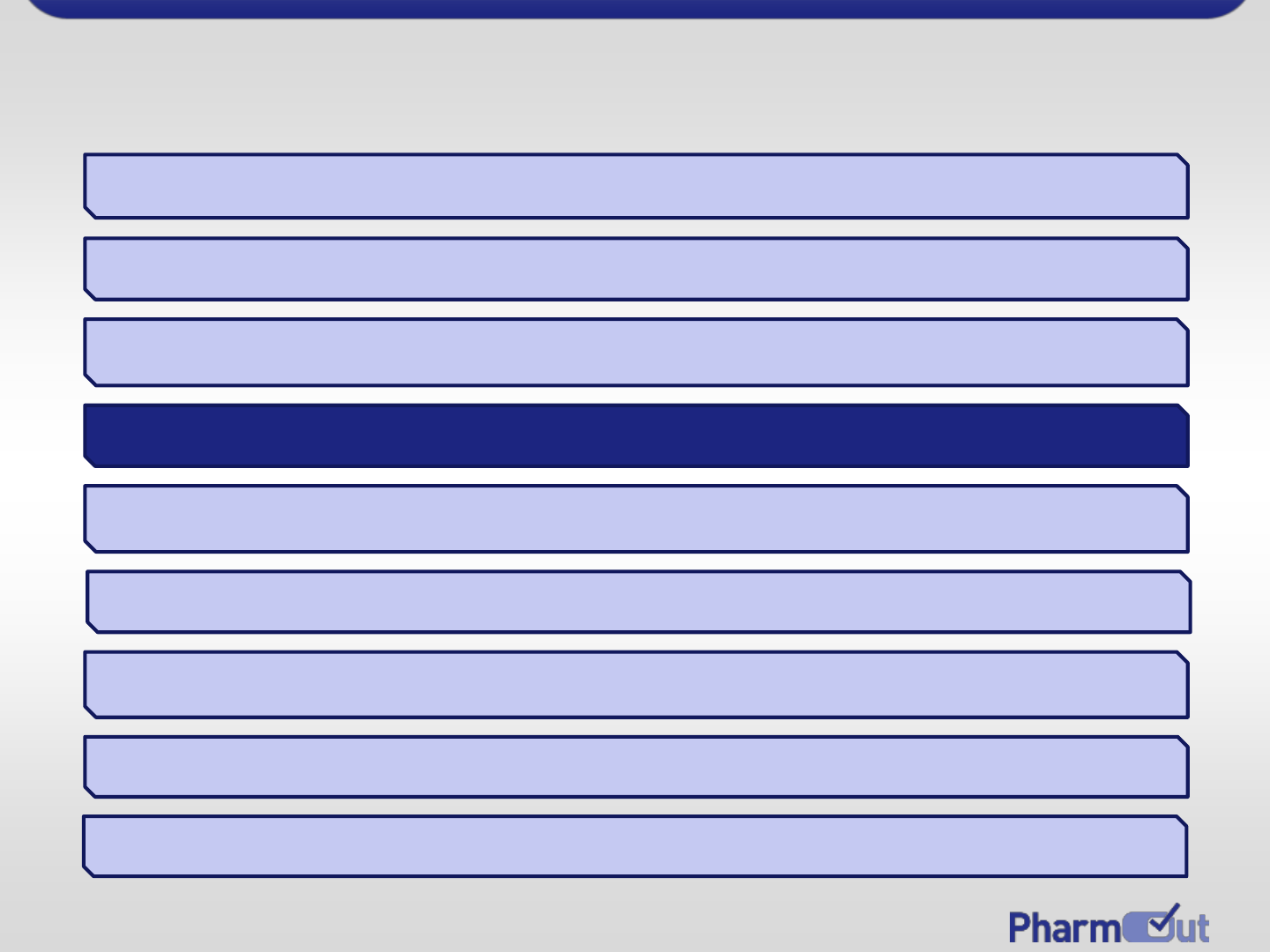
CAPA basics and
tools you could
use.
Presented by Trevor Schoerie
4 July, 2016

Slide 2 © PharmOut 2014
Outline
What is CAPA?
CAPA Tools
CAPA Workflow
Introduction

Slide 3 © PharmOut 2014
What is CAPA?
An improvement tool
used within good
manufacturing
practice (GMP)
principles and
various ISO
standards
Aims to prevent
issue recurrence
(corrective action) or
to prevent issue
occurrence
(preventative action)
CAPA is the core of
continuous
improvement
systems
“… CAPA is a quality assurance system, which addresses
quality events, which may occur or could be anticipated to
occur during healthcare products manufacturing.”

Slide 4 © PharmOut 2014
Correction, corrective action and
preventative action
Issue
Correction
Corrective Action
Preventative Action
Investigation

Slide 5 © PharmOut 2014
Key CAPA definitions
Corrective and Preventative Action
A systematic approach that includes actions needed to
correct (correction), avoid recurrence (corrective
action), and eliminate the cause of potential non-
conforming product and other quality problems
(preventative action)
CAPA
Action to eliminate a detected non-conformity.
Corrections typically are one-time fixes. A correction is
an immediate solution such as a repair or rework.
• Also known as remedial or containment action.
Correction

Slide 6 © PharmOut 2014
Key CAPA definitions
Action to eliminate the causes of a detected
nonconformity or other undesirable situation.
The corrective action should eliminate the
recurrence of the issue.
Corrective Action
Action to eliminate the causes of a potential
nonconformity or other undesirable potential
situation. Preventative action should prevent
the occurrence of the potential issue.
Preventative Action

Slide 7 © PharmOut 2014
Corrective or preventative?
• Product failing specifications
• Confirmed customer complaint
• Use of obsolete documents
• Audit finding
Name it corrective action only
if you already have a product
non-conformance or process
non-compliance
• Developing adverse trends from
monitoring systems
o Shifts
o Trends
o High Variability, and so on
Name it preventative action
whenever the product, process
or system is still in conformance
but you discover root cause with
the potential to create non-
conformities
• Changing to new material or new
design
• Implement new (enhanced) processes
Name it preventative action if
it is purely a recommendation to
enhance or improve any
product, process or system

Slide 8 © PharmOut 2014
The Quality System and CAPA
Quality System
• Defines processes to fulfil product requirements, customer satisfaction
and continuous improvement
QMS
• How quality policies are implemented and quality objectives are
achieved
Continuous Improvement
• Ongoing activities to evaluate and enhance the Quality System
Data Analysis
• Demonstrates the suitability and effectiveness of the QMS
Corrective Actions
• Identifies action needed to correct the causes of identified problems

Slide 9 © PharmOut 2014
Quality Systems Centre - CAPA
CAPA
Complaints
Customer &
Supplier Audits
Regulatory
Inspections
Stability
Environmental
Monitoring
Annual Product
Reviews
Continuous
Product
Verification
Internal
Audits
Deviations

Slide 10 © PharmOut 2014
Tools for identifying causes
Tools
• 5 Whys
• (Who, What, When,
Where, Why, How)
• Cause & Effect
• Problem Description
• Fault Tree Diagram
• Change Analysis
• Factor Analysis
• Brain storming
Tools
• Flow charting
• Root Cause Mapping
• Simple Checklists
• Fishbone diagrams
• Pareto chart
• Failure Mode & Effect
Analysis
• Change Analysis

Slide 11 © PharmOut 2014
Tool: 5 Why’s
• Step 1:
Establish a problem statement
E.g. “I was late to CAPA training today”
• Step 2:
Ask (and answer) the question “Why” 5 times
• Step 3:
The root cause becomes apparent by the 5
th
Why

Slide 12 © PharmOut 2014
Tool: Fishbone Diagram
Example:
CAUSES OF BURNT TOAST
No security on
Toaster Settings
Burnt
Toast
Equipment
Environment
People
Didn’t know correct
Toasting Setting
Didn’t read
instructions
Morning –
in a hurry
New Toaster
No Testing of
Settings done
before use
Procedure not
followed/
available
Process
Process not
tested/
validated
Material
Bread of
poor Quality/
Too dry

Slide 13 © PharmOut 2014
Tool: Problem Description
Date (week of)
Facts
October 12
Results within specifications
October 19
Floor maintenance housekeeping performed during the
weekend
October
26
High variability of results. The two balances were found
out of tolerance. Balances were calibrated.
November
2
Results within specifications
November
9
Results within specifications
November
16
Results within specifications
November
23
Results within specifications
November
30
Results within specifications
November
7
Floor maintenance housekeeping performed during the
weekend
November
14
High variability of results. The two balances were found
out of tolerance. Balances were calibrated.
November
21
Results within specifications

Slide 14 © PharmOut 2014
Tool: Change Analysis
0
10
20
30
40
50
60
70
80
February March April May June July August September October November December
Change Analysis Graph

Slide 15 © PharmOut 2014
Tool: Comparison Matrix
Is
Is not
Possible causes
Further action
Where
Johnstown
Plant
Cedarville
Plant
Equipment;
Inspection
procedures
Interview plant
management
What
Pit fragments
less than
5mm
No fragments
larger than
5mm
Improperly
maintained
pitters;
Performance data;
Line speeds
Analyse
maintenance
logs
and production
records
When
Production
after July 30
Production
before July 30
Change in fruit
characteristics;
Pitter
performance
Analyse
maintenance logs
and fruit
characteristics
Who
Smith;
Abbot farms
All other
farms
Soft fruit
Measure fruit
softness

Slide 16 © PharmOut 2014
Types of barriers:
Tool: Barrier Analysis
Physical barriers
• Separation among
manufacturing or
packaging lines
• Emergency power supply
• Dedicated equipment
• Barcoding
• Keypad controlling doors
• Software that prevents
further input if a field is
not completed
Administrative barriers
• Training and
certifications
• Clear procedures and
policies
• Adequate supervision
• Adequate load of work
• Use of checklist
• Verification of critical
task by a second person

Slide 17 © PharmOut 2014
Tool: Standard Checklists
Checklists are beneficial in providing a standard,
consistent list of potential sources of error.
For example:
• Was the correct procedure followed?
• Was the person trained in the procedure?
• Does the procedure match actual practice?
• Is this a recurring issue?
• Was there an equipment problem?
• Was the equipment calibrated?

Slide 18 © PharmOut 2014
Tool: Brainstorming
Brainstorming can be used in association with other
Root Cause Analysis tools
Brainstorming is a method for
generating a large number of
creative ideas in a short period
of time
Approach:
• Unstructured shout-out ideas
• Thinking “outside the box”
• Structured rotation around the room for ideas

Slide 19 © PharmOut 2014
Chronology
Causes Of Burnt Toast
Time
Prior to today
Used old Toaster
Last night
Wife introduced New Toaster
8am
Awoke
after late night
8.10
Removed bread from Pantry. Noted old bread was dry
8.15
Inserted bread to toaster as per previous day
8.16
Depressed
Toasting lever
8.20
Toaster smoking, toast burnt
8.21
Pressed
abort and removed burnt toast
8.22
Recognised Toaster was new
8.23
Called wife to locate instructions. Sitting beside toaster
8.24
Went to work with no Breakfast

Slide 20 © PharmOut 2014
Tool: Comparison Matrix
Comparison Matrix
• Tool aimed at focussing on the key areas implicated in the
problem and remove areas of investigation not implicated

Slide 21 © PharmOut 2014
Tool: Fault Tree Analysis
Fault-Tree Analysis
• Tool used to identify the key activity streams that may have led to the
problem being displayed
• Helps identify the true root cause(s)
This method is similar to the Root Cause
Mapping

Slide 22 © PharmOut 2014
Root Cause Analysis (RCA) tips
Root Cause Analysis (RCA) is a key element to a site’s
Quality System.
Important considerations include:
• Don’t forget the past – has this occurred previously?
• Don’t stop at the first plausible explanation – complete
the process to eliminate
all
other possible causes
• There may be
more than one
root cause
• If you do not find a confirmed root cause, address the
potential root causes and monitor the issue
• Monitor – follow-up on implemented actions

Slide 23 © PharmOut 2014
CAPA work flow
Identify
Root Cause
Assess the
significance
Assess the
risk
Assess the
potential
for
recurrence

Slide 24 © PharmOut 2014
CAPA form
Section 1– Issue Details
Section 2 – Immediate actions
Section 3 – Investigation
Section 5 – Corrective actions
Section 6 – Preventative actions
Section 7 – CAPA Implementation Plan
Section 8 – CAPA Effectiveness Check and Summary
Section 4 – Root Cause
Section 9 – Approval

Slide 25 © PharmOut 2014
Describe the issue

Slide 26 © PharmOut 2014
CAPA Form
Section 1– Issue Details
Section 2 – Immediate actions
Section 3 – Investigation
Section 5 – Corrective actions
Section 6 – Preventative actions
Section 7 – CAPA Implementation Plan
Section 8 – CAPA Effectiveness Check and Summary
Section 4 – Root Cause
Section 9 – Approval

Slide 27 © PharmOut 2014
List the immediate actions taken

Slide 28 © PharmOut 2014
CAPA Form
Section 1– Issue Details
Section 2 – Immediate actions
Section 3 – Investigation
Section 5 – Corrective actions
Section 6 – Preventative actions
Section 7 – CAPA Implementation Plan
Section 8 – CAPA Effectiveness Check and Summary
Section 4 – Root Cause
Section 9 – Approval

Slide 29 © PharmOut 2014
Describe investigation undertaken

Slide 30 © PharmOut 2014
CAPA Form
Section 1– Issue Details
Section 2 – Immediate actions
Section 3 – Investigation
Section 5 – Corrective actions
Section 6 – Preventative actions
Section 7 – CAPA Implementation Plan
Section 8 – CAPA Effectiveness Check and Summary
Section 4 – Root Cause
Section 9 – Approval

Slide 31 © PharmOut 2014
List the root cause(s) of issue

Slide 32 © PharmOut 2014
CAPA Form
Section 1– Issue Details
Section 2 – Immediate actions
Section 3 – Investigation
Section 5 – Corrective actions
Section 6 – Preventative actions
Section 7 – CAPA Implementation Plan
Section 8 – CAPA Effectiveness Check and Summary
Section 4 – Root Cause
Section 9 – Approval

Slide 33 © PharmOut 2014
List proposed corrective actions

Slide 34 © PharmOut 2014
CAPA Form
Section 1– Issue Details
Section 2 – Immediate actions
Section 3 – Investigation
Section 5 – Corrective actions
Section 6 – Preventative actions
Section 7 – CAPA Implementation Plan
Section 8 – CAPA Effectiveness Check and Summary
Section 4 – Root Cause
Section 9 – Approval

Slide 35 © PharmOut 2014
List proposed preventative actions

Slide 36 © PharmOut 2014
CAPA Form
Section 1– Issue Details
Section 2 – Immediate actions
Section 3 – Investigation
Section 5 – Corrective actions
Section 6 – Preventative actions
Section 7 – CAPA Implementation Plan
Section 8 – CAPA Effectiveness Check and Summary
Section 4 – Root Cause
Section 9 – Approval

Slide 37 © PharmOut 2014
Detail the CAPA Implementation Plan

Slide 38 © PharmOut 2014
Detail the CAPA Implementation Plan

Slide 39 © PharmOut 2014
CAPA Form
Section 1– Issue Details
Section 2 – Immediate actions
Section 3 – Investigation
Section 5 – Corrective actions
Section 6 – Preventative actions
Section 7 – CAPA Implementation Plan
Section 8 – CAPA Effectiveness Check and Summary
Section 4 – Root Cause
Section 9 – Approval

Slide 40 © PharmOut 2014
Describe post-implementation
effectiveness checks

Slide 41 © PharmOut 2014
Describe post-implementation
effectiveness checks

Slide 42 © PharmOut 2014
CAPA Form
Section 1– Issue Details
Section 2 – Immediate actions
Section 3 – Investigation
Section 5 – Corrective actions
Section 6 – Preventative actions
Section 7 – CAPA Implementation Plan
Section 8 – CAPA Effectiveness Check and Summary
Section 4 – Root Cause
Section 9 – Approval

Slide 43 © PharmOut 2014
Final CAPA Approval

Slide 44 © PharmOut 2014
10 common mistakes
01 Timeliness (lack of)
02 Everything is an isolated event
03 Root cause not identified
04 Correcting the symptom instead of the cause
05 Lack of interim corrective actions
06 Root cause identified by not corrected
07 Lack of true preventative action
08 Lack of effectiveness verification
09 Multiple CAPA systems without correlation
10 Abuse of human error and retraining

Slide 45 © PharmOut 2014
Thank you for your time.
Questions?
Trevor Schoerie
trevor.schoerie@pharmout.net
Managing Director
www.pharmout.net
